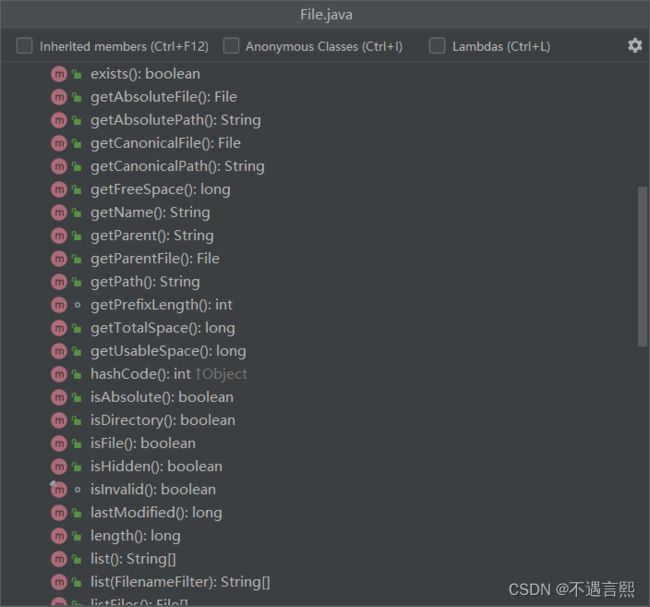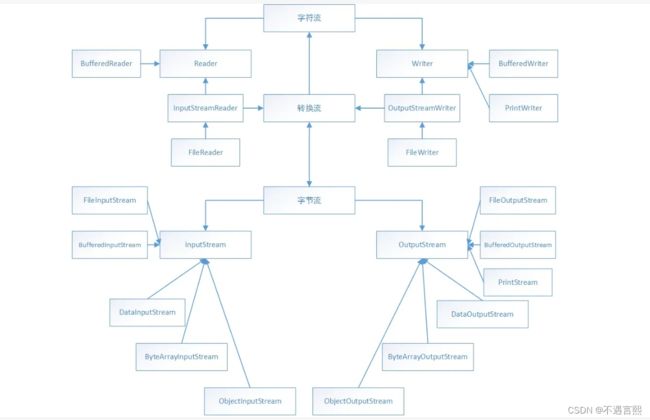IO流文件相关部分
1. 文件
1.1 什么是文件
文件,并不陌生,他是保存数据的地方,比如大家经常使用的word文档,txt文档,excel文件…都是文件。
1.2 文件流
文件在程序中是以流的形式来操作的
流:数据在数据源(文件)和程序(内存)之间经历的路径。
输入流:数据从数据源(文件)到程序(内存)的路径。
输出流:数据从程序(内存)到数据源(文件)的路径。
1.3 常用的文件操作
1.3.1 创建文件对象相关构造器和方法
new File(String pathName)//根据路径构建一个File对象
new File(File parent,String child)//根据父目录文件+子路径构建
new File(String parent,String child)//根据父目录+子路径构建
1.3.2 案例演示
public void create01() {
String filePath = "e:\\news1.txt";
File file = new File(filePath);
try {
file.createNewFile();
System.out.println("文件创建成功");
} catch (IOException e) {
e.printStackTrace();
}
}
public void create02() {
File parentFile = new File("e:\\");
String fileName = "news2.txt";
//这里的 file 对象,在 java 程序中,只是一个对象
//只有执行了 createNewFile 方法,才会真正的,在磁盘创建该文件
File file = new File(parentFile, fileName);
try {
file.createNewFile();
System.out.println("创建成功~");
} catch (IOException e) {
e.printStackTrace();
}
}
public void create03() {
String parentPath = "e:\\";
String fileName = "news4.txt";
File file = new File(parentPath, fileName);
try {
file.createNewFile();
System.out.println("创建成功~");
} catch (IOException e) {
e.printStackTrace();
}
}
1.3.4 获取文件的相关信息
2. IO流原理及流的分类
2.1 Java IO流原理
- I/O是Input/Output的缩写,I/O技术是非常实用的技术,用于处理数据传输。如读写文件,网络通讯等。
- Java程序中,对于数据的输入/输出操作以“流(stream)”的方式进行。
- java.io包下提供了各种“流”类和接口,用以获取不同种类的数据,并通过方法输入或输出数据。
- 输入input:读取外部数据(磁盘,光盘等存储设备的数据)到程序(内存)中。
- 输出output:将程序(内存)数据输出到磁盘,光盘等存储设备中。
2.2 流的分类
- 按操作数据单位不同分为:字节流二进制文件,字符流文本文件。
- 按数据的流向不同分为:输入流,输出流。
- 按流的角色的不同分为:节点流,处理六/包装流。
3. IO流中常用类
3.1 FileInputStream
使用 FileInputStream 读取 hello.txt 文件,并将文件内容显示到控制台
正常读取
public void readFile01() {
String filePath = "e:\\hello.txt";
int readData = 0;
FileInputStream fileInputStream = null;
try {
//创建 FileInputStream 对象,用于读取 文件
fileInputStream = new FileInputStream(filePath);
//从该输入流读取一个字节的数据。 如果没有输入可用,此方法将阻止。
//如果返回-1 , 表示读取完毕
while ((readData = fileInputStream.read()) != -1) {
System.out.print((char)readData);//转成 char 显示
}
} catch (IOException e) {
e.printStackTrace();
} finally {
//关闭文件流,释放资源.
try {
fileInputStream.close();
} catch (IOException e) {
e.printStackTrace();
}
}
}
使用字节数组
public void readFile02() {
String filePath = "e:\\hello.txt";
//字节数组
byte[] buf = new byte[8]; //一次读取 8 个字节. int readLen = 0;
FileInputStream fileInputStream = null;
try {
//创建 FileInputStream 对象,用于读取 文件
fileInputStream = new FileInputStream(filePath);
//从该输入流读取最多 b.length 字节的数据到字节数组。 此方法将阻塞,直到某些输入可用。
//如果返回-1 , 表示读取完毕
//如果读取正常, 返回实际读取的字节数
while ((readLen = fileInputStream.read(buf)) != -1) {
System.out.print(new String(buf, 0, readLen));//显示
}
} catch (IOException e) {
e.printStackTrace();
} finally {
//关闭文件流,释放资源.
try {
fileInputStream.close();
} catch (IOException e) {
e.printStackTrace();
}
}
3.2 FileOutputStream
public void writeFile() {
//创建 FileOutputStream 对象
String filePath = "e:\\a.txt";
FileOutputStream fileOutputStream = null;
try {
//得到 FileOutputStream 对象
//1. new FileOutputStream(filePath) 创建方式,当写入内容是,会覆盖原来的内容
//2. new FileOutputStream(filePath, true) 创建方式,当写入内容是,是追加到文件后面
fileOutputStream = new FileOutputStream(filePath, true);
//写入一个字节
//fileOutputStream.write('B');//
//写入字符串
String str = "hello,world!";
//str.getBytes() 可以把 字符串-> 字节数组
//fileOutputStream.write(str.getBytes());
/*
write(byte[] b, int off, int len) 将 len 字节从位于偏移量 off 的指定字节数组写入此文件输出流
*/
fileOutputStream.write(str.getBytes(), 0, 3);
} catch (IOException e) {
e.printStackTrace();
} finally {
try {
fileOutputStream.close();
} catch (IOException e) {
e.printStackTrace();
}
}
}
3.3 FileReader 和 FileWriter
3.3.1 FileReader 相关方法:
- new FileReader(File/String)
- read: 每次读取单个字符,返回该字符,如果到文件末尾返回-1
- read(char[]):批量读取多个字符到数组,返回读取到的字符串,如果到文件末尾返回-1
3.3.2 FileWriter 常用方法
- new FileWriter(File/String):覆盖模式,相当于流的指针在首段
- new FileWriter(File/String,true):追加模式,相当于流的指针在尾端
- write(int):写入单个数值
- write(char[]):写入指定数组
- write(char,off,len):写入指定字符串的指定部分
- write(String str):写入整个字符串
- write(String,off,len):写入字符串的指定部分
注意,FileWriter使用后,必须呀关闭(close)或刷新(flush),否则写不到指定的文件!
3.3.3 FileReader 应用实例
String filePath = "e:\\story.txt";
FileReader fileReader = null;
int data = 0;
//1. 创建 FileReader 对象
fileReader = new FileReader(filePath);
//循环读取 使用 read, 单个字符读取
while ((data = fileReader.read()) != -1) {
System.out.print((char) data);
}
3.3.4 FileWriter 应用实例
String filePath = "d:\\note.txt";
//创建 FileWriter 对象
FileWriter fileWriter = null;
char[] chars = {'a', 'b', 'c'};
fileWriter = new FileWriter(filePath);//默认是覆盖写入
// 3) write(int):写入单个字符
fileWriter.write('B');
// 4) write(char[]):写入指定数组
fileWriter.write(chars);
// 5) write(char[],off,len):写入指定数组的指定部分
fileWriter.write("IO流原理".toCharArray(), 0, 3);
// 6) write(string):写入整个字符串
fileWriter.write(" 你好北京~");
fileWriter.write("风雨之后,定见彩虹");
// 7) write(string,off,len):写入字符串的指定部分
fileWriter.write("上海天津", 0, 2);
4. 结语
io流中文件相关部分就到这里,自己试着写一下就可以掌握,利用Java程序实现文件还是很有意思的。



